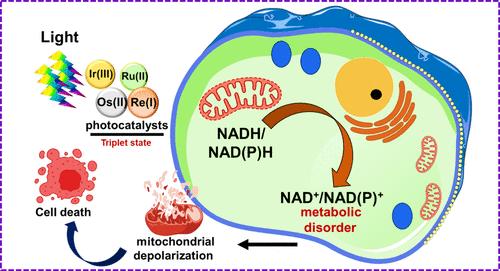Intracellular Photocatalytic NADH/NAD(P)H Oxidation for Cancer Drug Development
IF 14.4
1区 化学
Q1 CHEMISTRY, MULTIDISCIPLINARY
引用次数: 0
Abstract
Photocatalytic cancer therapy (PCT) has emerged as a cutting-edge anticancer mechanism of action, harnessing light energy to mediate the catalytic oxidation of intracellular substrates. PCT is of significant current importance due to its potential to address the limitations of conventional chemotherapy, particularly drug resistance and side effects. This approach offers a noninvasive, targeted cancer treatment option by utilizing metal-based photocatalysts to induce redox and metabolic disorders within cancer cells. The photocatalysts disrupt the cancer cell metabolism by converting NADH/NAD(P)H to NAD+/NAD(P)+ via catalytic photoredox processes, altering intracellular NAD+/NADH or NAD(P)+/NAD(P)H ratios, which are crucial for cellular metabolism. Ir(III), Ru(II), Re(I), and Os(II) photocatalysts demonstrated promising PCT efficacy. Despite these developments, gaps remain in the literature for translating this new anticancer mechanism into clinical trials. This Perspective critically examines the developments in this research area and provides future directions for designing efficient photocatalysts for PCT.

求助全文
约1分钟内获得全文
求助全文
来源期刊
CiteScore
24.40
自引率
6.00%
发文量
2398
审稿时长
1.6 months
期刊介绍:
The flagship journal of the American Chemical Society, known as the Journal of the American Chemical Society (JACS), has been a prestigious publication since its establishment in 1879. It holds a preeminent position in the field of chemistry and related interdisciplinary sciences. JACS is committed to disseminating cutting-edge research papers, covering a wide range of topics, and encompasses approximately 19,000 pages of Articles, Communications, and Perspectives annually. With a weekly publication frequency, JACS plays a vital role in advancing the field of chemistry by providing essential research.

 求助内容:
求助内容: 应助结果提醒方式:
应助结果提醒方式:


